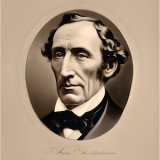The Neighbouring Families Page #3
The Neighbouring Families is a delightful collection of fairy tales by Hans Christian Andersen. The book explores themes of friendship, love, and the significant impact of societal and familiar relations on individual lives, presented through enchanting narratives starring both humans and fantastical creatures living in harmony. The stories in this book are tinged with humor, wit, and classic Andersonian wisdom that amuse as well as provoke deeper reflection.
stood in the ranks with the others, but it did not suit them at all. They were full, and so they left the pigeons, exchanging opinions about them, slipped in under the garden palings, and when they found the door leading into the house open, one of them, who was more than full, and therefore felt brave, hopped on to the threshold. "Peep!" said he; "I may venture that." "Peep!" said the other; "so may I, and something more too!" and he hopped into the room. No one was there; the third sparrow, seeing this, flew still farther into the room, exclaiming, "All or nothing! It is a curious man's nest all the same; and what have they put up here? What is it?" Close to the sparrows the roses were blooming; they were reflected in the water, and the charred beams leaned against the overhanging chimney. "Do tell me what this is. How comes this in a room at the Hall?" And all three sparrows wanted to fly over the roses and the chimney, but flew against a flat wall. It was all a picture, a great splendid picture, which the artist had painted from a sketch. "Peep!" said the sparrows, "it's nothing. It only looks like something. Peep! that is 'the beautiful.' Do you understand it? I don't." And they flew away, for some people came into the room. Days and years went by. The pigeons had often cooed, not to say growled--the spiteful creatures; the sparrows had been frozen in winter and had lived merrily in summer: they were all betrothed, or married, or whatever you like to call it. They had little ones, and of course each one thought his own the handsomest and cleverest; one flew this way, another that, and when they met they recognised each other by their "Peep!" and the three scrapes with the left foot. The eldest had remained an old maid and had no nest nor young ones. It was her pet idea to see a great city, so she flew to Copenhagen. There was a large house painted in many gay colours standing close to the castle and the canal, upon which latter were to be seen many ships laden with apples and pottery. The windows of the house were broader at the bottom than at the top, and when the sparrows looked through them, every room appeared to them like a tulip with the brightest colours and shades. But in the middle of the tulip stood white men, made of marble; a few were of plaster; still, looked at with sparrows' eyes, that comes to the same thing. Up on the roof stood a metal chariot drawn by metal horses, and the goddess of Victory, also of metal, was driving. It was Thorwaldsen's Museum. "How it shines! how it shines!" said the maiden sparrow. "I suppose that is 'the beautiful.' Peep! But here it is larger than a peacock." She still remembered what in her childhood's days her mother had looked upon as the greatest among the beautiful. She flew down into the courtyard: there everything was extremely fine. Palms and branches were painted on the walls, and in the middle of the court stood a great blooming rose-tree spreading out its fresh boughs, covered with roses, over a grave. Thither flew the maiden sparrow, for she saw several of her own kind there. A "peep" and three foot-scrapings--in this way she had often greeted throughout the year, and no one here had responded, for those who are once parted do not meet every day; and so this greeting had become a habit with her. But to-day two old sparrows and a young one answered with a "peep" and the thrice-repeated scrape with the left foot. "Ah! Good-day! good-day!" They were two old ones from the nest and a little one of the family. "Do we meet here? It's a grand place, but there's not much to eat. This is 'the beautiful.' Peep!" Many people came out of the side rooms where the beautiful marble statues stood and approached the grave where lay the great master who had created these works of art. All stood with enraptured faces round Thorwaldsen's grave, and a few picked up the fallen rose-leaves and preserved them. They had come from afar: one from mighty England, others from Germany and France. The fairest of the ladies plucked one of the roses and hid it in her bosom. Then the sparrows thought that the roses reigned here, and that the house had been built for their sake. That appeared to them to be really too much, but since all the people showed their love for the roses, they did not wish to be behindhand. "Peep!" they said sweeping the ground with their tails, and blinking with one eye at the roses, they had not looked at them long before they were convinced that they were their old neighbours. And so they really were. The painter who had drawn the rose-bush near the ruined house, had afterwards obtained permission to dig it up, and had given it to the architect, for finer roses had never been seen. The architect had planted it upon Thorwaldsen's grave, where it bloomed as an emblem of 'the beautiful' and yielded fragrant red rose-leaves to be carried as mementoes to distant lands. "Have you obtained an appointment here in the city?" asked the sparrows. The roses nodded; they recognized their grey neighbours and were pleased to see them again. "How glorious it is to live and to bloom, to see old friends again, and happy faces every day. It is as if every day were a festival." "Peep!" said the sparrows. "Yes, they are really our old neighbours; we remember their origin near the pond. Peep! how they have got on. Yes, some succeed while they are asleep. Ah! there's a faded leaf; I can see that quite plainly." And they pecked at it till it fell off. But the tree stood there fresher and greener than ever; the roses bloomed in the sunshine on Thorwaldsen's grave and became associated with his immortal name.
Translation
Translate and read this book in other languages:
Select another language:
- - Select -
- 简体中文 (Chinese - Simplified)
- 繁體中文 (Chinese - Traditional)
- Español (Spanish)
- Esperanto (Esperanto)
- 日本語 (Japanese)
- Português (Portuguese)
- Deutsch (German)
- العربية (Arabic)
- Français (French)
- Русский (Russian)
- ಕನ್ನಡ (Kannada)
- 한국어 (Korean)
- עברית (Hebrew)
- Gaeilge (Irish)
- Українська (Ukrainian)
- اردو (Urdu)
- Magyar (Hungarian)
- मानक हिन्दी (Hindi)
- Indonesia (Indonesian)
- Italiano (Italian)
- தமிழ் (Tamil)
- Türkçe (Turkish)
- తెలుగు (Telugu)
- ภาษาไทย (Thai)
- Tiếng Việt (Vietnamese)
- Čeština (Czech)
- Polski (Polish)
- Bahasa Indonesia (Indonesian)
- Românește (Romanian)
- Nederlands (Dutch)
- Ελληνικά (Greek)
- Latinum (Latin)
- Svenska (Swedish)
- Dansk (Danish)
- Suomi (Finnish)
- فارسی (Persian)
- ייִדיש (Yiddish)
- հայերեն (Armenian)
- Norsk (Norwegian)
- English (English)
Citation
Use the citation below to add this book to your bibliography:
Style:MLAChicagoAPA
"The Neighbouring Families Books." Literature.com. STANDS4 LLC, 2025. Web. 22 Jan. 2025. <https://www.literature.com/book/the_neighbouring_families_2198>.




Discuss this The Neighbouring Families book with the community:
Report Comment
We're doing our best to make sure our content is useful, accurate and safe.
If by any chance you spot an inappropriate comment while navigating through our website please use this form to let us know, and we'll take care of it shortly.
Attachment
You need to be logged in to favorite.
Log In